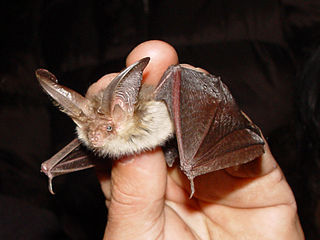
The southeastern myotis is a small bat found throughout the Gulf Coastal Plain and the Lower Mississippi Alluvial Plain of the southeastern United States.

Hellhole is a large and deep pit cave in Germany Valley, eastern West Virginia. It’s the 7th longest cave in the United States and is home to almost half of the world's population of Virginia big-eared bats. At 737 feet, Hellhole is the deepest of several caves in the Valley.

The Mexican big-eared bat is a species of vesper bat endemic to Mexico. They are nocturnal and insectivorous. Their very large ears are located across their foreheads, and when captured, the bats are observed to curl their ears in a protective manner. The adults are usually brown colored, while the juveniles are usually a smokey brown color. They have small noses.

Rafinesque's big-eared bat, sometimes known as the southeastern big-eared bat, is a species of vesper bat native to the southeastern United States.

Townsend's big-eared bat is a species of vesper bat.

The Vespertilioninae are a subfamily of vesper bats from the family Vespertilionidae.

The Virginia big-eared bat is one of two endangered subspecies of the Townsend's big-eared bat. It is found in Virginia, West Virginia, North Carolina, and Kentucky. In 1979, the US Fish and Wildlife Service categorized this as an endangered species. There are about 20,000 left and most of them can be found in West Virginia. The Virginia Big-Eared Bat is the state bat of Virginia.

The Ozark big-eared bat is an endangered species found only in a small number of caves in Arkansas, Oklahoma and Missouri, the southern central United States. Also known as the western big-eared bat, the long-eared bat, and the lump-nosed bat, its appearance is defined by a pair of outsize ears and a lump-adorned nose. The Ozark big-eared bat is the largest and reddest of the five subspecies of Corynorhinus townsendii and is medium-sized and weighs from 0.2 to 0.5 ounces. It has very large, 1-inch-long ears that connect at the base across the forehead. The snout has large, prominent lumps above the nostrils. These particular bats feed on moths and other insects; they forage along forest edges.

Originally known as the Oklahoma Bat Caves National Wildlife Refuge, Ozark Plateau National Wildlife Refuge was established for the protection of endangered bats and their habitat. The refuge is made up of several parcels of land located in northeastern Oklahoma. These parcels contain numerous caves considered crucial for the bats' survival.

A maternity colony refers to a temporary association of reproductive female bats for giving birth to, nursing, and weaning their pups. The colonies are initiated by pregnant bats. After giving birth, the colony consists of the lactating females and their offspring. After weaning, juveniles will leave the maternity colony, and the colony itself will break apart. The size of a maternity colony is highly variable by species, with some species forming colonies consisting of ten or fewer individuals, while the largest maternity colony in the world in Bracken Cave is estimated to have over 15 million bats.

Plecotini is a tribe of bats in the family Vespertilionidae. It contains several genera found throughout the Northern Hemisphere, in Eurasia, North Africa, and North America. Several genera in this tribe are known as big-eared bats or long-eared bats. It also contains the spotted bat and barbastelles.











